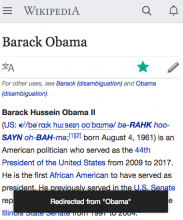This RFC has been scheduled for public discussion on June 28 (Wednesday) at 21:00 UTC (2pm PDT, 23:00 CEST). As always, the discussion will take place in the IRC channel #wikimedia-office
Problem statement
Currently /wiki/Redirect responds with the Target page, with three notable differences:
- A "Redirected from .." message is rendered.
- A piece of JavaScript is inserted that will jump to the destination #Section (if any).
- A piece of JavaScript is inserted to normalise the address bar from /wiki/Redirect to /wiki/Target#Section.
Internals:
- Page markup (wikitext) refers to the title as specified. – [[Redirect]] is saved as-is, no pre-save transformation)
- Page rendering refers to the title as specified – HTML: <a href="/wiki/Redirect">
- When clicking on such link within the wiki, or otherwise navigating "to" the redirect, the server responds with a modified version of the response for the target of the redirect. – /wiki/Redirect responds the same as /wiki/Target, including a <link rel=canonical> specifying Target as canonical, and a special header informing the reader "Redirected from Redirect".
- Once the page is rendered, JavaScript does two things:
- Jump to the intended section (if any).
- Swap the address bar from /wiki/Redirect to /wiki/Target. This encourages further social sharing to share the canonical link, and makes it so that those other people will not needlessly see "Redirected from Redirect" - which doesn't apply to those readers.
Benefits:
- Parser cache: Changing the redirect does not require invalidating parser cache of incoming links.
- Performance: "Following" a redirect responds quickly (no HTTP redirect).
- Usability: Users know when they followed a redirect (header message "Redirected from"), and the message doesn't show for others when you share the link.
- Search engines: No indexing of duplicate content. (due to canonical url).
Problems:
- Redirect to heading: When redirecting to a heading on a destination page (e.g. Topic redirecting to General#Topic), the browser does not natively jump to this heading because it's rendering content at /wiki/Topic not Topic#Topic or General#Topic. This is currently worked around with JavaScript. While this technically works it is bad in two ways:
- Performance: The jump happens very late. Sometimes 5-10 seconds after the first paint, because it waits for all content to arrive and all JavaScript to arrive and execute.
- Fallback: In our Grade C experience for older (but supported) browsers, the jump never happens.
- Fallback: It also means that on supported browsers, the jump doesn't happen if there were intermittent connection issues.
- Fallback: There is no recovery for the user when the jump doesn't happen. There is no manual way to get to this information (it's hidden in invisible JSON data)
Solution 1
Change the response of /wiki/Redirect to be an HTTP redirect to /wiki/Target?rdfrom=Redirect#Section. When viewing /wiki/Target?rdfrom=Redirect#Section, client-side code normalises the address bar to /wiki/Target#Section.
This addresses all the problems.
- Drawback: Users will be subject to an HTTP redirect.
- Benefit (compared to Solution 2): Redirects are instantly up-to-date (no need to wait for job queue).
Solution 2
Same as solution 1, but in addition, optimise the common case by changing the Parser to resolve to this url ahead of time.
- Benefit: Faster user experience for the common case.
- Drawback: Updating of urls depends on job queue, similar to template transclusion updates.
